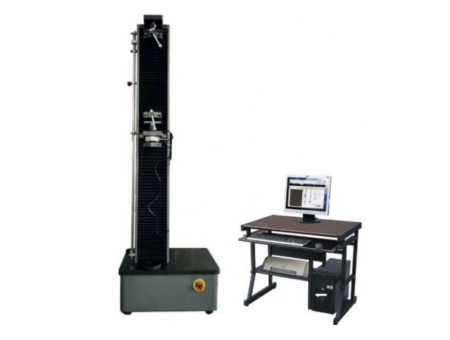What is tensile strength testing for medical devices?
Face masks, as an essential personal hygiene protective product, directly impact the health and safety of the wearer. Among the many quality indicators for masks, the tensile strength of the ear loops and their connection to the mask body is particularly important.
During mask production, the tensile strength of the elastic bands directly affects wearing comfort and safety. If the elastic bands are too loose, the mask may fall off; if they are too tight, it may cause ear discomfort or even breakage. This is where the Automatic Servo Medical Mask Tensile Testing Machine becomes crucial.

Detailed Working Principle:
Force Application and Measurement
When the test begins, the loading system activates, converting power into tensile force on the sample via a transmission mechanism.
Force sensors (such as strain gauge sensors) respond to changes in force on the sample, generating electrical signals. These signals are amplified and processed by a data processing system to convert them into readable force values.
Strain gauges convert external force into electrical signals through the minute deformation of elastic elements, achieving precise force measurement using the bridge circuit principle.
Deformation Tracking
Displacement sensors record the displacement of the sample during the force application process, providing elongation data.
Extensometers are particularly important in high-precision testing, as they can accurately measure minute changes in a specimen and are suitable for different types of specimens and gauge lengths.
Data Processing and Analysis: The control system integrates force and displacement data, displaying it in real time on a monitor to generate tensile curves.
By analyzing these curves, important parameters of the material, such as yield point, fracture strength, and elastic modulus, can be determined.
Equipment Operation Procedure
Equipment Preparation and Sample Preparation
Equipment Inspection: Before operation, check that the power cord is intact and properly grounded, that the mechanical parts are operating normally, and that the control system (including buttons, display screen, etc.) is functioning correctly.
Parameter Adjustment: Adjust the equipment parameters according to the testing requirements, such as testing speed and testing range. Typically, the tensile speed is set to 100 mm/min.
Sample Preparation: Randomly select mask samples according to relevant standards (e.g., GB/T 13773.2) and perform necessary temperature and humidity pretreatment. Pretreatment conditions may include placing the sample in a specific temperature and humidity environment for a certain period.
Sample Installation and Test Start-up
Sample Installation: Install the prepared mask sample onto the clamping device of the equipment. The test hook should be installed on the upper clamp of the tensile testing machine. During testing, the mask straps should be suspended vertically on the test hook, and the mask body should be clamped axially in the middle of the clamp, ensuring a secure and reliable fit.
Test Start-up: Turn on the software control system, power on the testing machine, select the appropriate test type, and start the test. During the test, observe the equipment's display screen and pay attention to the test results.
Testing Process and Precautions
Observe Test Results: During the test, observe whether the mask straps and the connection between the straps and the mask body show any breakage, and record the test results.
Safe Operation: When operating the mask tensile testing machine, always wear protective gloves to avoid hand injuries. Do not insert fingers or other objects into the moving parts of the equipment to prevent accidents.
Test Completion and Data Processing
End Test: After the test is completed, press the "Test End" button to turn off the equipment power and remove the sample.
Data Processing: Clean the clamping devices of the equipment to ensure it is clean. Then, perform data processing and analysis based on the test results, such as calculating the average, maximum, and minimum values of the breaking strength, and other statistical parameters.
Print Report: If necessary, the test results can be output to a Word document and a test report can be printed.
Equipment Maintenance and Upkeep
Regular Cleaning: Regularly clean the equipment, including both the exterior and interior, to maintain its cleanliness and normal operation.
Inspection and Maintenance: Inspect the equipment's power cord and interfaces for damage or looseness. Regularly apply lubricant to the mechanical parts to maintain their flexibility and prevent rust. Clean the equipment's control system to ensure the proper functioning of buttons, displays, etc.
Calibration and Lubrication: Regularly check the accuracy of the equipment's sensors and measurement systems. If any deviations are found, calibrate them. Simultaneously, lubricate the equipment regularly to ensure its normal operation and extend its service life.
Applications and Importance:
Tensile testing machines are widely used in metals, plastics, textiles, paper, and other fields. They are indispensable for quality control and are also key tools for new material research and development. They help engineers and researchers understand the mechanical behavior of materials, optimize product design, and ensure product quality, thereby driving industrial and technological progress.
Fully automatic tensile testing machines are suitable for testing the tensile strength, breaking force, elastic modulus, elongation, sealing strength, T-peel strength, 90° peel strength, and 180° peel strength of various materials such as plastic films, sheets, rubber, composite films, extruded films, foils, paper, medical patches, release paper, and non-woven fabrics. They are widely used in the food and pharmaceutical industries, quality inspection departments, and research institutions.
As a key piece of equipment for ensuring mask quality, the tensile testing machine for masks, with its precise testing capabilities and standardized operating procedures, has built a solid defense for quality control in mask production. The fully automatic tensile testing machine, in particular, plays a vital role in multiple industries due to its wide applicability, helping various sectors achieve product quality improvement and technological innovation. Whether it's masks protecting personal health or various materials driving industrial development, tensile testing machines are quietly contributing, becoming an indispensable "unsung hero" in the field of quality testing.

